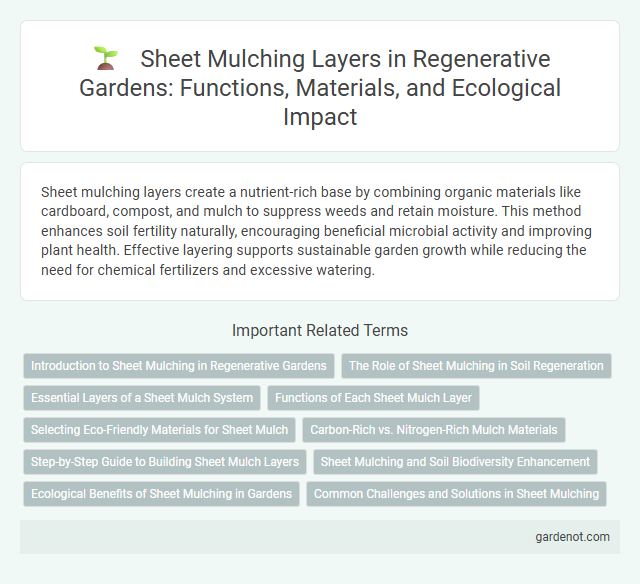Sheet mulching layers create a nutrient-rich base by combining organic materials like cardboard, compost, and mulch to suppress weeds and retain moisture. This method enhances soil fertility naturally, encouraging beneficial microbial activity and improving plant health. Effective layering supports sustainable garden growth while reducing the need for chemical fertilizers and excessive watering.
Introduction to Sheet Mulching in Regenerative Gardens
Sheet mulching in regenerative gardens involves layering organic materials such as cardboard, compost, and mulch directly onto the soil to suppress weeds and build fertility. This permaculture technique enhances soil structure, promotes microbial life, and conserves moisture by mimicking natural forest floor processes. Effective sheet mulching accelerates soil regeneration, reduces erosion, and supports sustainable plant growth without the need for chemical inputs.
The Role of Sheet Mulching in Soil Regeneration
Sheet mulching plays a crucial role in soil regeneration by suppressing weeds, retaining moisture, and enhancing soil structure through the gradual decomposition of organic layers. This method enriches microbial activity and promotes nutrient cycling, leading to improved soil fertility and plant health. By mimicking natural forest floor processes, sheet mulching accelerates the restoration of degraded soils in regenerative gardens.
Essential Layers of a Sheet Mulch System
The essential layers of a sheet mulch system include a base layer of cardboard or newspaper that suppresses weeds and retains moisture, followed by a nutrient-rich compost layer that promotes soil fertility and microbial activity. Next, a thick mulch layer of organic materials such as straw, leaves, or wood chips protects the soil from erosion, conserves moisture, and enhances soil structure. These combined layers create a regenerative garden environment by improving soil health, reducing water usage, and fostering sustainable plant growth.
Functions of Each Sheet Mulch Layer
Each sheet mulching layer plays a critical role in regenerative gardening by suppressing weeds, retaining soil moisture, and enhancing nutrient availability. The base layer, typically cardboard or newspaper, blocks sunlight to prevent weed growth while decomposing to improve soil texture. Subsequent layers of organic matter such as compost and mulch gradually break down, feeding soil microbes and enriching the earth to foster healthier plant growth.
Selecting Eco-Friendly Materials for Sheet Mulch
Choosing eco-friendly materials for sheet mulching is essential to enhance soil health and promote sustainable gardening practices in regenerative gardens. Organic components like cardboard, newspaper, untreated straw, and compostable plant matter create natural barriers that retain moisture, suppress weeds, and enrich soil microbiota. Prioritizing biodegradable and non-toxic materials ensures minimal environmental impact while supporting the garden's ecological balance.
Carbon-Rich vs. Nitrogen-Rich Mulch Materials
Sheet mulching relies on layering carbon-rich materials such as dried leaves, straw, and cardboard to create a moisture-retentive, weed-suppressing base that feeds soil microbes. Nitrogen-rich materials like grass clippings, kitchen scraps, and fresh green vegetation are added to accelerate decomposition and enhance soil fertility. Balancing carbon-rich and nitrogen-rich mulch layers optimizes soil microbial activity, promoting nutrient cycling and healthy plant growth in regenerative gardens.
Step-by-Step Guide to Building Sheet Mulch Layers
Start your sheet mulching by laying a base layer of cardboard or newspaper to suppress weeds and retain moisture. Follow with alternating layers of nitrogen-rich green materials like grass clippings and carbon-rich brown materials such as dried leaves or straw. Top it off with a thick layer of compost and mulch to nourish soil microbes and protect the layers beneath for effective decomposition and soil regeneration.
Sheet Mulching and Soil Biodiversity Enhancement
Sheet mulching is a regenerative gardening technique that involves layering organic materials to suppress weeds, retain moisture, and improve soil structure. This method enhances soil biodiversity by fostering a habitat for beneficial microorganisms, earthworms, and fungi, which contribute to nutrient cycling and soil health. Over time, the decomposing layers increase organic matter content, promoting a resilient and fertile growing environment.
Ecological Benefits of Sheet Mulching in Gardens
Sheet mulching enhances soil biodiversity by creating a habitat for beneficial microbes, fungi, and earthworms that improve nutrient cycling and soil structure. This method suppresses weeds naturally, reducing the need for chemical herbicides and promoting healthier plant growth. By retaining moisture and preventing erosion, sheet mulching fosters a resilient garden ecosystem that supports long-term ecological balance.
Common Challenges and Solutions in Sheet Mulching
Sheet mulching often faces challenges such as weed persistence due to incomplete coverage and poor-quality materials, which can impede decomposition and soil health. Using thick layers of organic matter like cardboard or newspaper combined with high-carbon mulch materials can enhance weed suppression and promote microbial activity. Ensuring adequate moisture retention and avoiding compaction are critical solutions to create an effective, nutrient-rich foundation for regenerative gardens.
Sheet mulching layer Infographic

 gardenot.com
gardenot.com